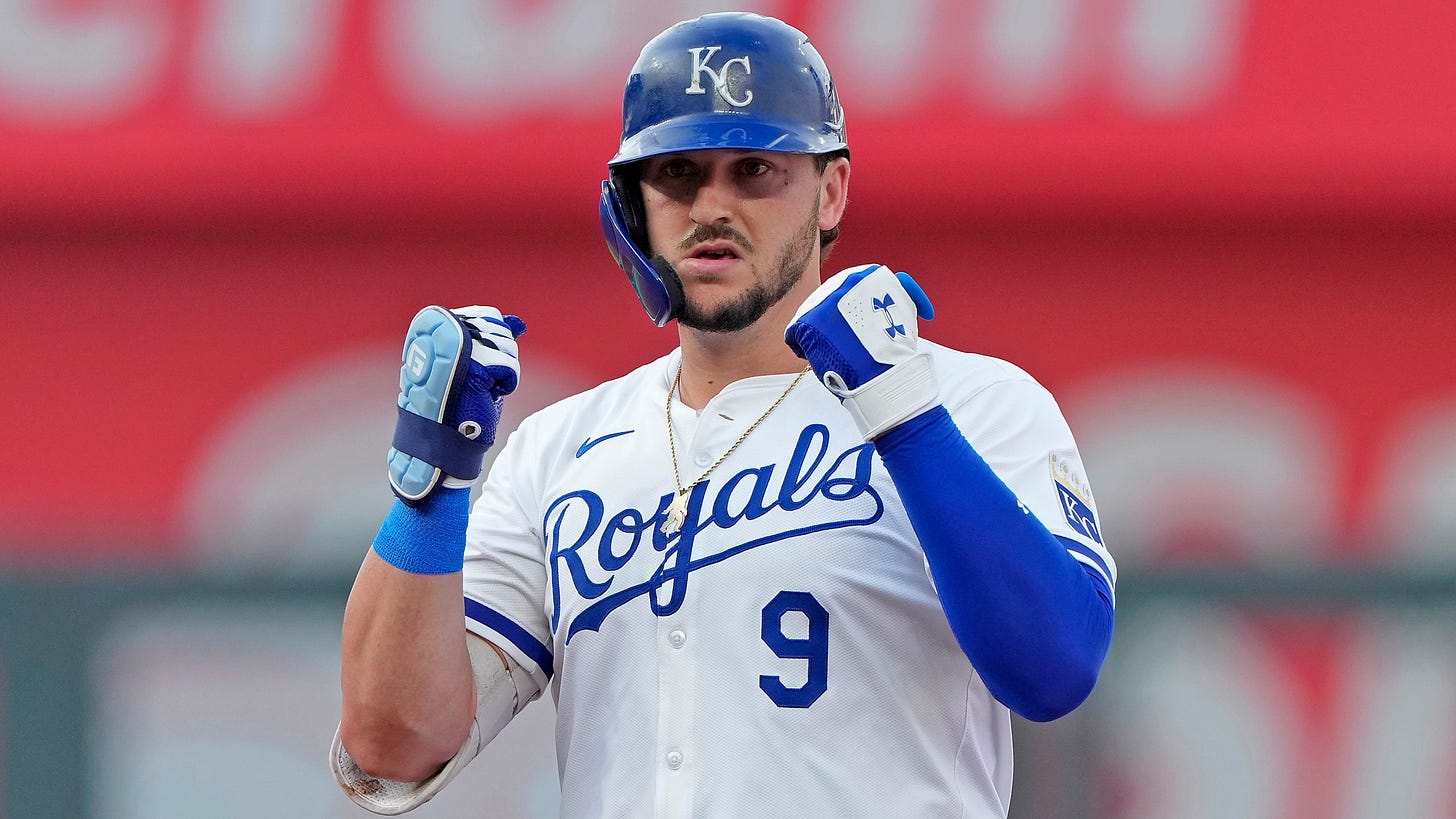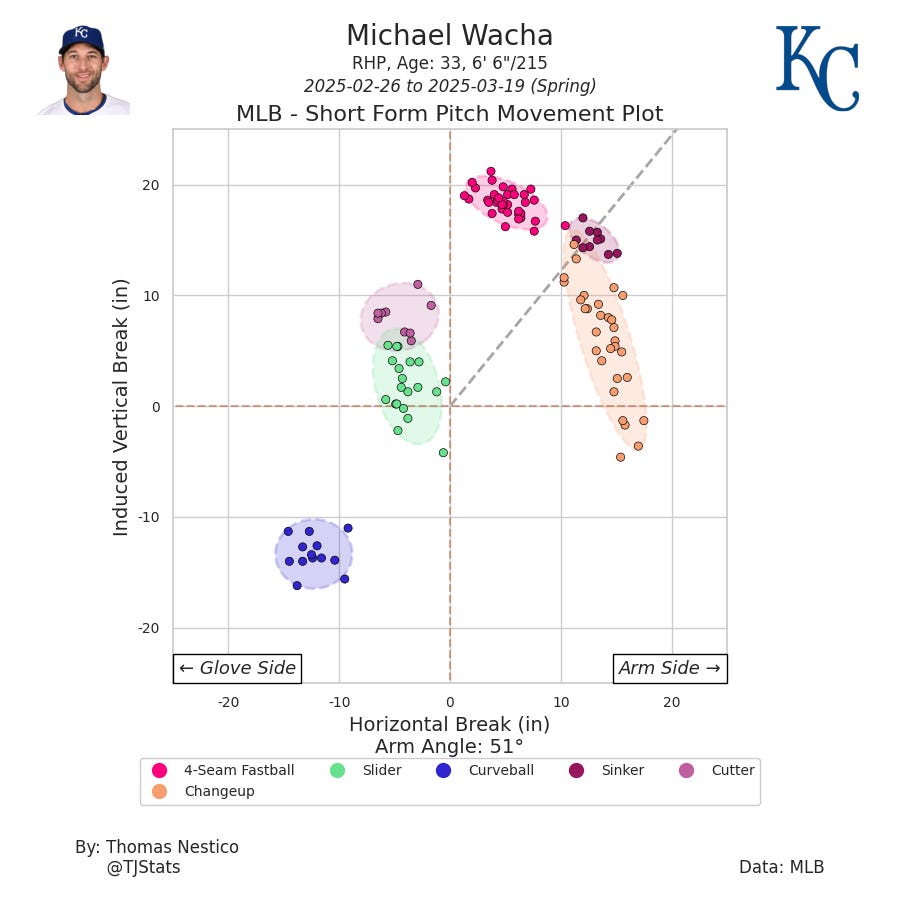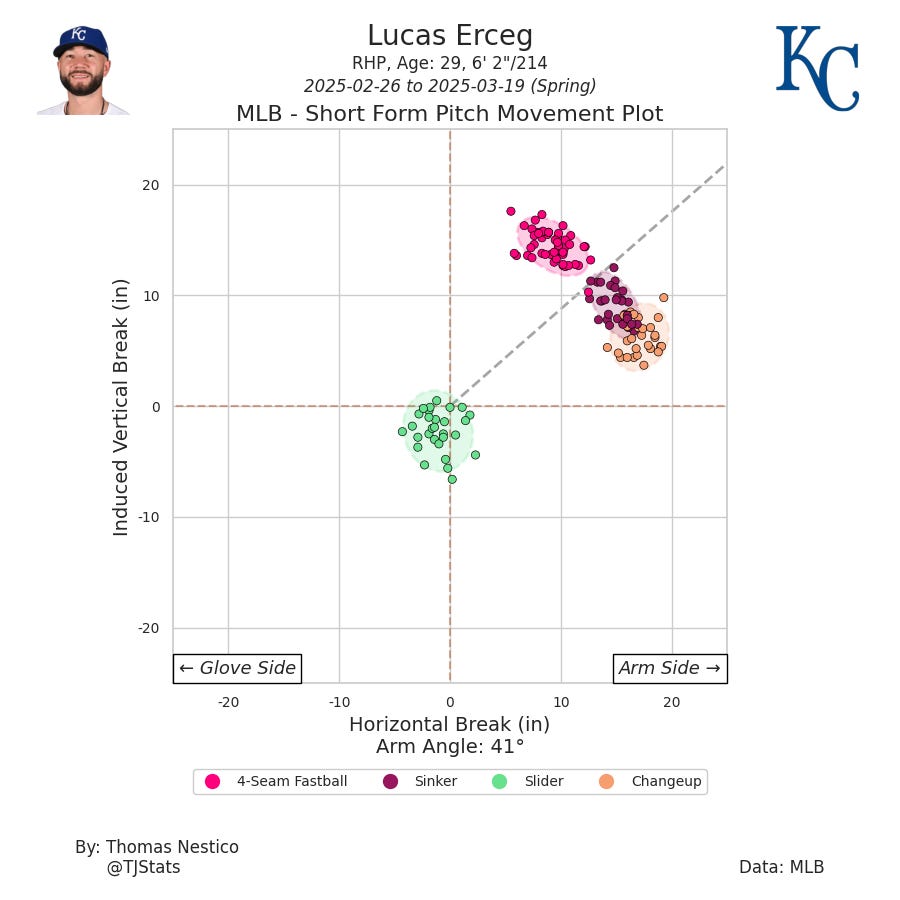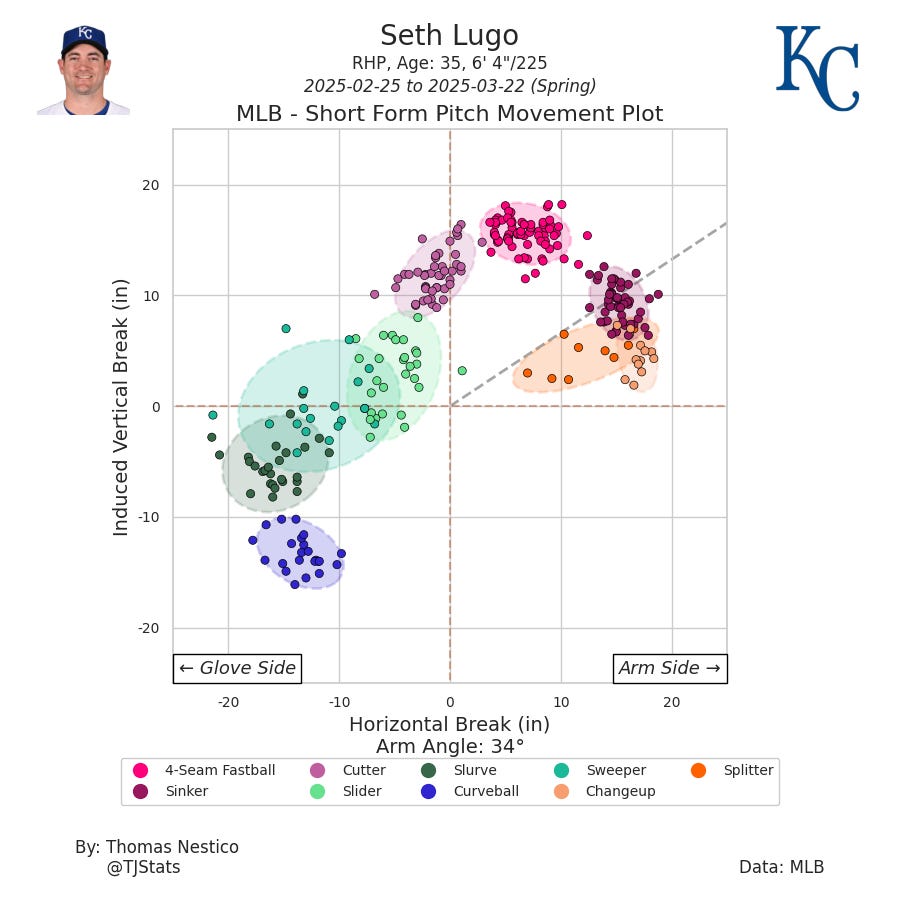Spring Statcast Standouts
Kansas City's Spring Training leaders in exit velocity, hard-hit rate, whiff rate and more
Just like that, Cactus League play is over. An Opening Day matchup pitting the Royals against the defending American League Central champion Cleveland Guardians is set for Thursday, the first salvo in what will surely be a dogged race for the division crown between these two, Detroit and Minnesota.
Before Cole Ragans lets loose that first pitch of 2025, let’s rewind a bit and dive into the Statcast data from spring. With the roster mostly set — the pitching staff is locked in already, in fact — we’re not using this information to determine bench spots or DFA’s.
They’re just fun to look at.
Well, they’re actually a bit more than that. Some of the figures may provide a bit of signal moving forward, like a player posting a new maximum exit velocity (potentially a nod to untapped power) or a pitcher ratcheting up the spin rate on a curveball (possibly unlocking an enhanced movement profile).
Royals Hitters
Maximum Exit Velocity
Vinnie Pasquantino, 117.5 MPH; represents a massive jump from his career-high 112.7 MPH max EV and would’ve tied him for sixth in MLB last season with Aaron Judge. Pasquantino tapping into an elite power tier as he matures would be a huge boon for the Royals lineup, but he’ll need to overcome a recent hamstring strain to open the season.
Jac Caglianone, 115.4 MPH; get used to seeing Caglianone’s name on the max EV lists — he’s got the kind of raw power that could potentially lead the league in exit velocity readings.
Dairon Blanco, 113.2 MPH; a 3.6 MPH increase from his career-high 109.6 MPH.
Bobby Witt Jr., 112.8 MPH
Bryan Gonzalez, 112 MPH
Average Exit Velocity (min. 10 batted balls)
Hunter Renfroe, 95.7 MPH
Maikel Garcia, 95.6 MPH; as a borderline elite defender and baserunner, Garcia brings a lot of underappreciated value to the table for the Royals. He’s always carried quality batted-ball metrics, but if he can take another step forward at the plate, he’ll truly be a massively impactful, versatile piece for manager Matt Quatraro.
Vinnie Pasquantino, 95.4 MPH
Tyler Tolbert, 94.7 MPH; a bit of a spring surprise, Tolbert is known much more for his wheels than his power, but he did show off some pop in Surprise.
Jac Caglianone, 94.6 MPH
Hard-Hit Rate (min. 10 batted balls)
Maikel Garcia, 61.3%
Tyler Tolbert, 60%
Peyton Wilson, 58.3%
Drew Waters, 58.3%; Waters had a hard time making contact this spring with a 44.2% whiff rate, but when he did put bat to ball, it was usually with a 95+ MPH EV.
Vinnie Pasquantino, 57.9%
Barrel Rate (min. 10 batted balls)
Jac Calianone, 25%
Hunter Renfroe, 17.4%
Joey Wiemer, 17.4%
Bobby Witt Jr., 11.1%
Tyler Tolbert/Dairon Blanco, 10%
O-Swing/Chase Rate (min. 10 plate appearances)
Cavan Biggio, 4.9%
Nick Loftin, 12.3%; Biggio and Loftin each made strong cases for the Opening Day roster as similar players (versatile defenders with good plate discipline) and those plate skills were on full display for each throughout spring.
John Rave, 14.3%
Gavin Cross, 14.6%
Jonathan India, 15.3%; a massive boost in the leadoff spot for this year’s Royals, India’s patient approach and ability to lay off pitches outside the strike zone will pay huge dividends in 2025.
Whiff Rate (min. 10 plate appearances)
Jonathan India, 8%
Vinnie Pasquantino, 9.1%
Maikel Garcia, 9.4%
Luke Maile, 11.4%
Kyle Isbel, 13.8%
Royals Pitchers
Average Pitch Velocity (min. 5 pitches)
Junior Fernandez, Four-Seam Fastball, 98.4 MPH
Junior Fernandez, Sinker, 98.1 MPH; Fernandez throws gas with not one but two fastball variations, giving Kansas City some relief depth in the minors heading into 2025.
Steven Cruz, Four-Seam Fastball, 97.1 MPH
Lucas Erceg, Four-Seam Fastball, 97 MPH
Lucas Erceg, Sinker, 96.9 MPH; Luinder Avila, Four-Seam Fastball, 96.9 MPH
Whiff Rate (min. 10 plate appearances)
Luinder Avila, 45.8%
Lucas Erceg, 42%; the Royals fireman’s velocity was down a touch in Spring Training, but it didn’t impact his ability to make hitters look foolish.
Cruz Noriega, 41.4%
Junior Fernandez, 40.5%
Steven Zobac, 34.3%
Average Positive Induced Vertical Break (min. 5 pitches)
Michael Wacha, Four-Seam Fastball, +18.4 Inches
Brandon Johnson, Four-Seam Fastball, +18.2 Inches
Ross Stripling, Four-Seam Fastball, +18.1 Inches
Carlos Estevez, Four-Seam Fastball, +17.3 Inches
Kris Bubic, Four-Seam Fastball, +17.3 Inches
Average Negative Induced Vertical Break (min. 5 pitches)
Sam Long, Curveball, -14.5 Inches
Ross Stripling, Knuckle Curve, -13.4 Inches
Michael Wacha, Curveball, -13.3 Inches
Seth Lugo, Curveball, -13.3 Inches
Michael Lorenzen, Curveball, -13.2 Inches
Average Positive (Arm-Side/Run) Horizontal Break (min. 5 pitches)
Lucas Erceg, Changeup, 17.1 Inches
Seth Lugo, Changeup, +16.9 Inches
Ben Sears, Sinker, +16.7 Inches
Beck Way, Changeup, +16.6 Inches
Beck Way, Sinker, +16.5 Inches
Average Negative (Glove-Side/Sweep) Horizontal Break (min. 5 pitches)
Seth Lugo, Slurve, -15.8 Inches
Chris Stratton, Curveball, -15.7 Inches
John Schreiber, Sweeper, -14.2 Inches
Tyson Guerrero, Slider, -14 Inches
Seth Lugo, Curveball, -13.5 Inches; yes, of course Lugo shows up over and over and over here in the pitch movement charts. He showed off nine recorded pitches this spring, boasting his innate ability to manipulate the baseball.
Average Pitch Spin Rate (min. 5 pitches)
Seth Lugo, Curveball, 3,180 RPM
Chris Stratton, Curveball, 3,061 RPM
Seth Lugo, Slurve, 2,902 RPM
Luinder Avila, Curveball, 2,881 RPM; Avila looks like he could pitch out of the Kansas City bullpen right now, but fortunately, he doesn’t need to. There’s plenty of relief depth for the Royals, allowing Avila to continue developing as a starter unless/until he’s needed to whip this high-spin curveball at Major League opponents.
Jacob Wallace, Slurve, 2,840 RPM
tjStuff+ Overall (min. 10 plate appearances)
Steven Zobac, 104 tjStuff+
Steven Cruz, 104 tjStuff+
Andrew Hoffman, 103 tjStuff+
Junior Fernandez, 103 tjStuff+
Jonathan Bowlan/Hunter Harvey/Cole Ragans, 102 tjStuff+
tjStuff+ by Individual Pitch (min. 5 pitches)
Andrew Hoffman, Changeup, 112 tjStuff+; I absolutely love this pitch and Hoffman’s tweaks to make it an offering he can rely on in 2025 in Omaha. He added nine inches of drop and took off a bit of arm-side run while adding about 1 MPH to the pitch. This helped it gain an absurd 23 points in the tjStuff+ system year-over-year.
Chris Stratton, Curveball, 108 tjStuff+
Tyson Guerrero, Slider, 108 tjStuff+
Cole Ragans, Slider, 107 tjStuff+
Steven Cruz, Slider, 107 tjStuff+
With Spring Training in the rearview, it’s time to turn our attention to the 2025 regular season. On Thursday, I’ll publish my season preview, loaded with a record prediction, American League Central prognostication, X-factors for the Royals and much, much more. Subscribe for free to receive this in-depth look at the upcoming season in your inbox just hours before first pitch on Opening Day.











This is interesting. Wonder what a comparison of these numbers to the first two months of the season would look like at Memorial Day.
Interesting numbers. Can you say what average positive induced vertical break is? Fastballs don't rise overall so how is the zero point determined on that?